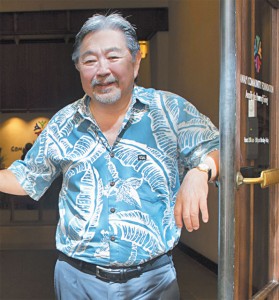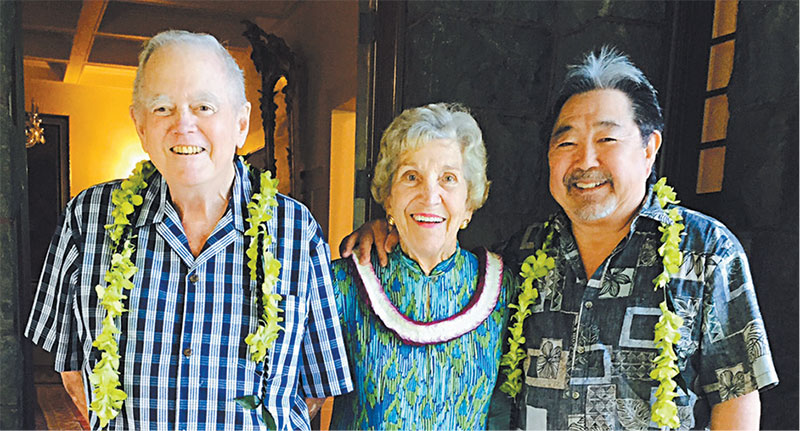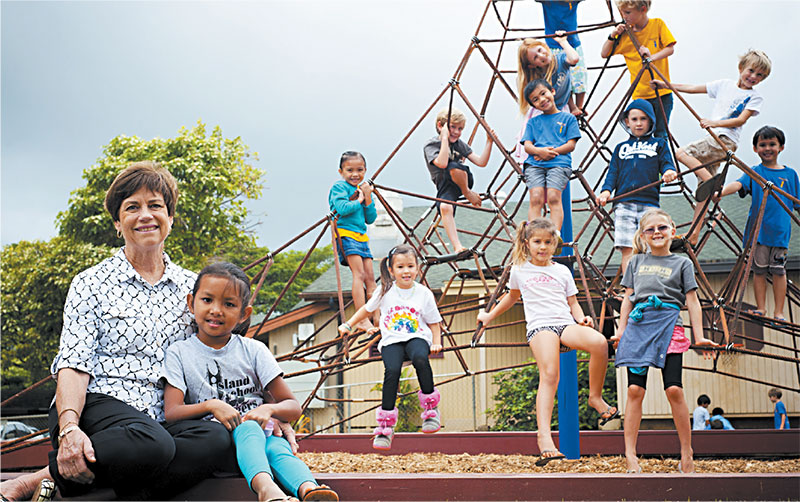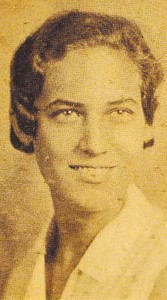The Power of Giving
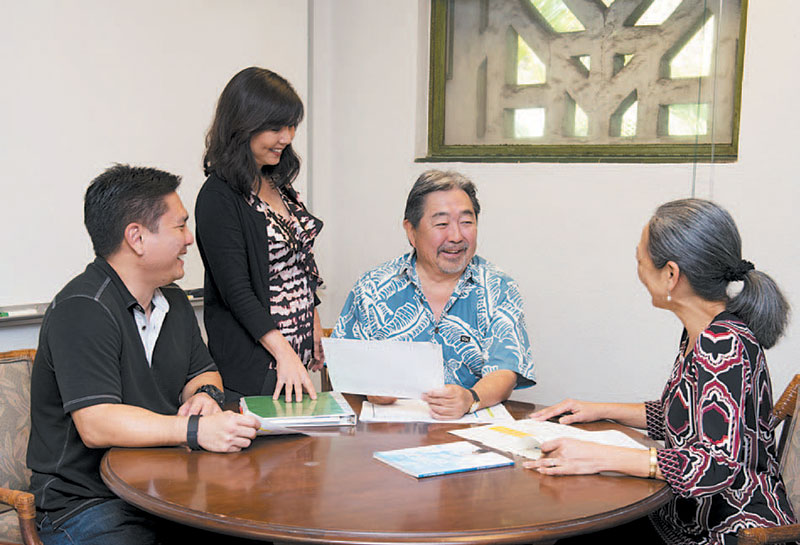
(from left) HCF senior scholarship officer Eric La‘a, director of communications Lynelle Marble, CEO Kelvin Taketa and director of programs-Omidyar Initiatives Robbie Kane gather in Taketa’s office to review plans for Hawaii Community Foundation’s centennial celebration
Under the direction of CEO Kelvin Taketa, Hawaii Community Foundation manages 700 trusts with assets of $600 million to benefit Hawaii and its people — including on Kauai — as it has for 100 years
The residents of Hawaii are a generous people. It is in our DNA. Whether sharing a home with multiple generations, buying chili tickets from our neighbor’s kids or filling fishnets held out on the side of the road to raise money for a volleyball team, we are not afraid to give back.
“The history of giving in Hawaii dates back to the 19th century, when ali‘i had the foresight to understand the importance of creating a legacy and providing for future generations,” says Kelvin Taketa, CEO of Hawaii Community Foundation, citing as examples The Queen’s Medical Center, Kamehameha Schools and Bishop Museum.
“Through their gifts, generations of Hawaii residents have been provided with access to health care, education and other services. As Hawaii grew, so did its history of giving. From the missionaries to the migrant plantation workers from China, Japan and the Philippines, they all found ways to help and support the community. This has evolved into modern-day legacy giving that includes individuals from all facets of the community.”
Celebrating its centennial this year, Hawaii Community Foundation (HCF) started as a gathering place for funds that were left behind in banks that lacked a will to direct their dispersal, allowing it to provide a pool of money to aid local charities.
“Originally, we were just set up as a repository for funds without thinking about synergy for those funds, but as we have gone along and funds share a commonality, then there is a way we can begin to have some cohesion,” says Taketa.
This pool has grown into an ocean, as it now manages more than 700 trusts with $600 million in assets that help 1,000-plus nonprofits each year.
Its century of experience coupled with the size of its assets allows HCF to leverage donations to maximize their impact.
“It gives us a level of relationships into the community that really is unparalleled,” says Taketa, who grew up on a cattle ranch in Maunawili, Oahu. “That is when you can start building real networks and start moving the needle around policy or systems change. It is exciting that we now have the platform to do that kind of work more then we did before — that’s fun!”
One example is its HousingASAP program, in which HCF brought together a dozen funders to meet with policy makers and service providers to battle the rate of homeless families returning to the streets. Its $4 million contribution led to not only 20 percent more families off the streets, but it also dropped their recidivism rate by 20 percent.
Doing important work to help those in need is at its heart, but the blood that allows that heart to beat begins with the generosity of the people of Hawaii.
“The community has been so supportive of many people who have been so successful here, so they have that instinct where they want to give back,” says Taketa from the HCF offices in the historic former C. Brewer building on Fort Street Mall.
“They come to us and we help them target their philanthropy so it matches with their passions, and help them think about it, tactically, how they are going to get done what they deeply care about. And then we manage those funds to make sure they are invested, so that we can make the biggest difference we can possibly make. It’s a partnership.”
Many of those partners are some of the biggest names in the Islands, such as Robert E. Black, Jack and Marie Lord, and Maude Woods Wodehouse, but more than 40 percent of its trusts are from living donors like Pierre Omidyar, the founder of eBay, who recently donated $60 million to HCF. (He previously worked through HCF to bring the Dalai Lama to Honolulu.)
While the big fish tend to make the largest splash, more than 200 ordinary working-class families have made commitments to HCF as well, including the Fias of Waipahu.
Jon and Eleyne Fia are both high school educators, Jon at Waipahu and Eleyne at Campbell, and they have both seen firsthand how important a little help can be in a kid’s life.
“I remember an angry boy who had been taken from his parents and thinking, if I don’t help him then who will?” says Eleyne, who has set aside funds for scholarships for kids from both of their schools.
“That young man went on to graduate from the U.S. Naval Academy and became a Navy SEAL. When you want to give up and walk away, that’s when you know you have to help.”
Her husband agrees. He was the first in his family to attend college, encouraged by his teachers to use football to pave the way there. Now, as an educator himself, he can pay this forward to the next generation.
“Simple actions can have such a huge impact on someone’s life,” says Jon, recalling a football player whose highlight tape he saw when he walked into the UH coaching office.
“We convinced him to walk on, worked with him to get tutoring and get his scores up. That young man graduated from UH as the Rainbow Warriors’ captain and MVP. It changed his life. You don’t have to be Bill Gates to give. Something small can make a difference.”
In 2014, HCF awarded $4.6 million in scholarships to Hawaii kids from its 200-plus scholarship trusts. To streamline the process for kids, it uses just one common application on its website for those funds, which the site organizes by the school they want to attend, where they are from, and the major they want to focus on, and then matches up the funds accordingly.
Last year, more than 4,000 kids applied and 2,300 were awarded some type of scholarship.
“Some are small, when you think about how much it costs to go to college. It may just be $1,000, and for the longest time I thought maybe we should be giving fewer kids more money,” says Taketa, who spent nearly two decades with The Nature Conservancy before joining HCF 18 years ago.
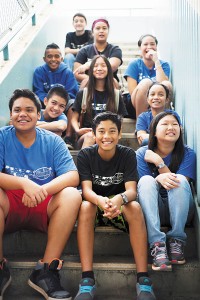
Students at Stevenson Middle School participate in HCF’s Connecting For Success program PHOTO BY ELYSE BUTLER
“But I will never forget talking to one of the students about how she felt when she got this scholarship, and she said, ‘It wasn’t the money, it was the fact that there was someone out there who believed in me that doesn’t even know who I am.’ This sense of validation that a scholarship gives a kid, that says, ‘We believe in you, we think you are on the right track, your dream is a good dream’ — that is almost more important than the money sometimes.”
Some dreams can start small, like Ellen Hamada’s love of sewing. She grew it into Fashion Center of Honolulu just after World War II, and used her talent to instruct generations of students over the next six decades.
When she died at the age of 91, she gifted her life insurance to HCF to create a fund for kids who wanted to pursue a career in fashion and design.
“She always said, ‘Sewing is my passion, my love, and I want to help younger generations keep it going,'” recalls her grandniece Kim Asato. “We couldn’t be happier. This scholarship keeps her legacy going.”
The direct impact of this gift can be seen in the life of Molokai native Kamalani Pico, who is currently studying fashion at Honolulu Community College with dreams of launching her own clothing line.
“She was such an inspiration and she gave so much to the community,” says Pico. “Now I want to do that, too, and use some of the money from my clothing line to give back, just like she did.”
From statewide initiatives to the life of a single student, HCF’s effect can be felt throughout the Islands, and as long as the generosity of Hawaii residents remains strong, HCF will continue to try to do the most good for everyone.
“We get to do great stuff,” says Taketa. “We get to aspire to make a big difference and we get to work with really good people. There is not a lot left to be desired after that. Each trust has a story, and it is our job not just to manage the money, but to keep those stories alive.”


